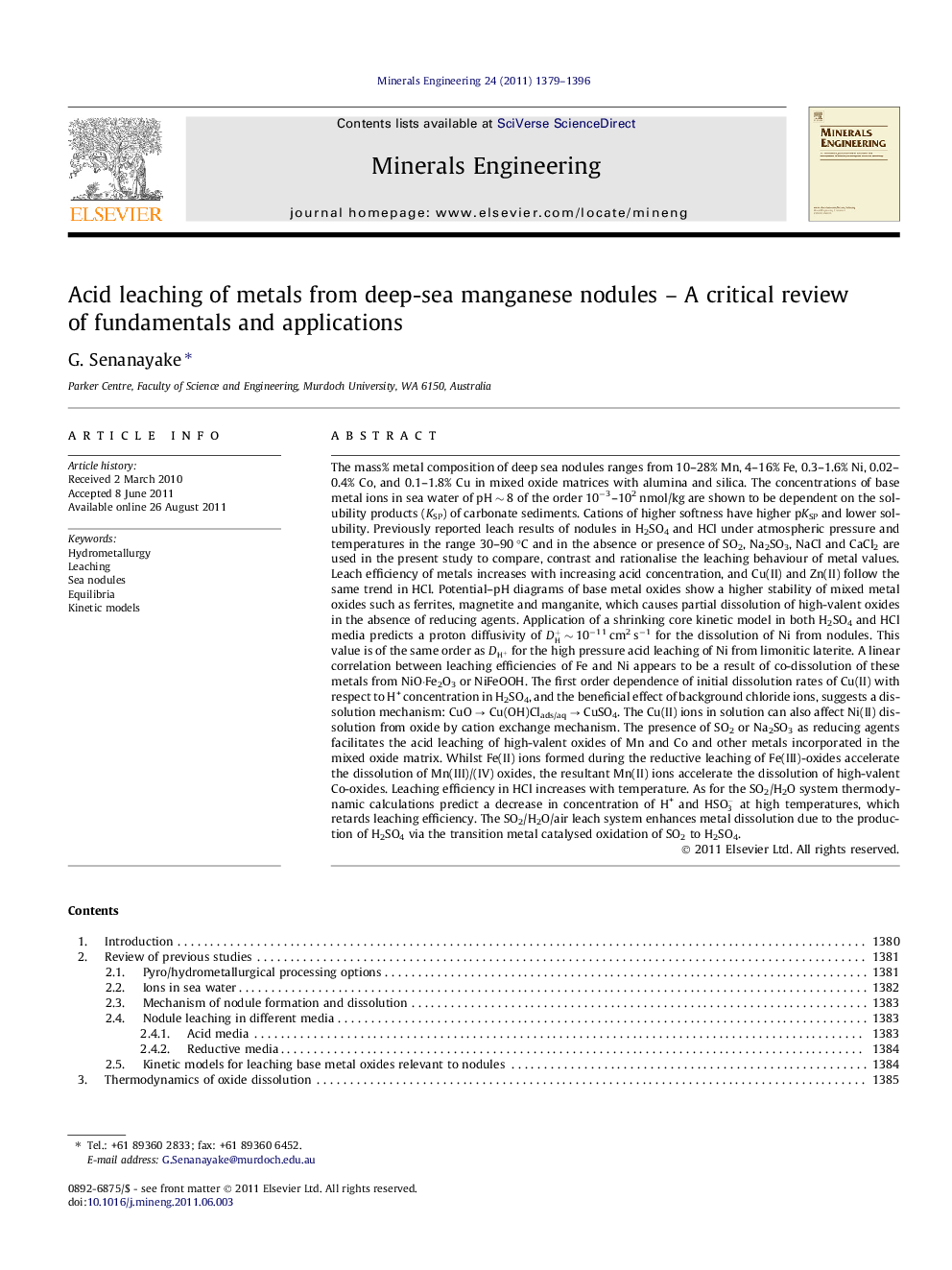| Article ID | Journal | Published Year | Pages | File Type |
|---|---|---|---|---|
| 233699 | Minerals Engineering | 2011 | 18 Pages |
The mass% metal composition of deep sea nodules ranges from 10–28% Mn, 4–16% Fe, 0.3–1.6% Ni, 0.02–0.4% Co, and 0.1–1.8% Cu in mixed oxide matrices with alumina and silica. The concentrations of base metal ions in sea water of pH ∼ 8 of the order 10−3–102 nmol/kg are shown to be dependent on the solubility products (KSP) of carbonate sediments. Cations of higher softness have higher pKSP and lower solubility. Previously reported leach results of nodules in H2SO4 and HCl under atmospheric pressure and temperatures in the range 30–90 °C and in the absence or presence of SO2, Na2SO3, NaCl and CaCl2 are used in the present study to compare, contrast and rationalise the leaching behaviour of metal values. Leach efficiency of metals increases with increasing acid concentration, and Cu(II) and Zn(II) follow the same trend in HCl. Potential–pH diagrams of base metal oxides show a higher stability of mixed metal oxides such as ferrites, magnetite and manganite, which causes partial dissolution of high-valent oxides in the absence of reducing agents. Application of a shrinking core kinetic model in both H2SO4 and HCl media predicts a proton diffusivity of DH+ ∼ 10−11 cm2 s−1 for the dissolution of Ni from nodules. This value is of the same order as DH+DH+ for the high pressure acid leaching of Ni from limonitic laterite. A linear correlation between leaching efficiencies of Fe and Ni appears to be a result of co-dissolution of these metals from NiO·Fe2O3 or NiFeOOH. The first order dependence of initial dissolution rates of Cu(II) with respect to H+ concentration in H2SO4, and the beneficial effect of background chloride ions, suggests a dissolution mechanism: CuO → Cu(OH)Clads/aq → CuSO4. The Cu(II) ions in solution can also affect Ni(II) dissolution from oxide by cation exchange mechanism. The presence of SO2 or Na2SO3 as reducing agents facilitates the acid leaching of high-valent oxides of Mn and Co and other metals incorporated in the mixed oxide matrix. Whilst Fe(II) ions formed during the reductive leaching of Fe(III)-oxides accelerate the dissolution of Mn(III)/(IV) oxides, the resultant Mn(II) ions accelerate the dissolution of high-valent Co-oxides. Leaching efficiency in HCl increases with temperature. As for the SO2/H2O system thermodynamic calculations predict a decrease in concentration of H+ and HSO3- at high temperatures, which retards leaching efficiency. The SO2/H2O/air leach system enhances metal dissolution due to the production of H2SO4 via the transition metal catalysed oxidation of SO2 to H2SO4.
Graphical abstractCorrelation of the apparent rate constant based on a shrinking core model as a function of acid concentration for Ni(II) or Fe(III) dissolution from manganese nodules and limonitic laterite ores under reductive or non-reductive conditions.Figure optionsDownload full-size imageDownload as PowerPoint slideHighlights► Cation softness and carbonate KSP affect oceanic metal ion concentrations but complexation enhance solubility of some ions. ► Acid destruction and reduction of high-valent mixed-oxides are essential for complete dissolution of metals from nodules. ► Proton diffusion controls Ni/Fe dissolution but chloride ions enhance leaching of metal ions which form chloro-complexes. ► Enhanced Cu(II) leaching in Cl–/H2SO4 via Cu(OH)Cl accelerates Ni(II) leaching via ion exchange.
